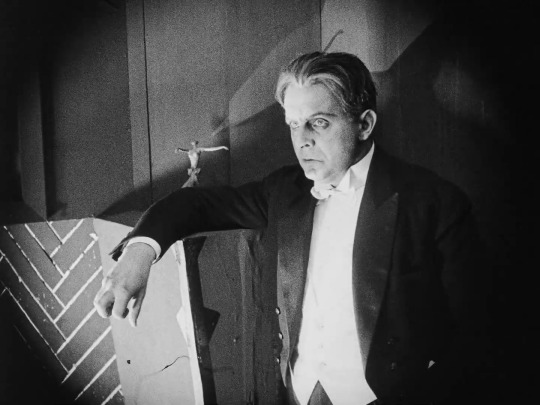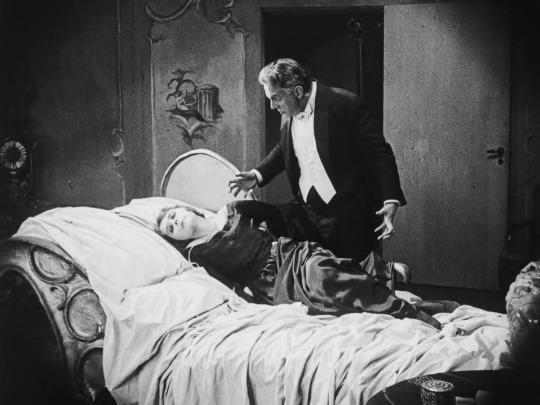#Stummfilm
Explore tagged Tumblr posts
Text

The inventor C.A. Rotwang (Rudolf Klein-Rogge) and his robotic invention (Brigitte Helm) in Fritz Lang's silent film classic Metropolis (1927).
#metropolis#1927#fritz lang#brigitte helm#c. a. rotwang#rudolf klein rogge#robot#silent film#silent movies#stummfilm
26 notes
·
View notes
Video
Nathalie Kovanko in Lost Dream (1919) by Truus, Bob & Jan too! Via Flickr: Vintage Russian postcard. Natalie Kovanko in Lost Dream/ Oброненнаr мечта (Viktor Tourjansky, Ermoliev 1919). The actor could be Tourjansky himself. The film title lacks in IMDb. With thanks to Natalia Noussinova for the identification. Nathalie Kovanko (1899-1967) was a Russian-Ukrainian actress who played in Russian and French silent cinema.
#vintage#Russian#1919#film#movies#cinema#Postcard#Postkarte#Ansichtskarte#Carte#Cartolina#Carte Postale#1910s#Viktor Tourjansky#Nathalie Kovanko#Vedette#Screen#STar#Silent#Schauspielerin#SChauspieler#Stummfilm#Darstellerin#Darsteller#ACtress#Actor#Actrice#Acteur#Lost Dream#Oброненнаr мечта
10 notes
·
View notes
Text
Der inszenierte Suizid
Die Könige von Babelsberg von Ralf Günther Berlin, 1920. Kriminalkommissar Walter Beneken wird an einen Tatort gerufen. Eine Frau liegt mit einer Schusswunde in ihrem Bett. Alles deutet auf einen Suizid hin. Sie war die Ehefrau von Fritz Lang, dem erfolgreichen Regisseur in der Stummfilmindustrie. Aber irgendwas kommt dem Kommissar merkwürdig vor. Die Details passen einfach nicht zusammen. Er…
2 notes
·
View notes
Text
Margit Barnay (* 5. April 1896 in Berlin als Margot Rosenstock; † 11. Januar 1974 in Berlin-Zehlendorf) war eine deutsche Stummfilmschauspielerin. -Wikipedia-
0 notes
Text
Recherche ist das A und O
Wenn man Romane mit historischen Elementen schreibt, muss man recherchieren, außer man schreibt Fantasy, das in einer selbst ausgedachten Welt spielt. Wenn ich nun beispielsweise einen Roman schreibe, der in der Weimarer Republik spielt, sollte ich wissen, wie es damals in den Städten ausgesehen hatte, was die Menschen für Kleidung getragen haben, wie sie von A nach B kamen, wie viel etwas…
#Autor#Autorin#Blog#Buchstaben#Dalibor#Französische Nationalbibliothek#Gegenwartsroman#Geschichte#Handlung#Helen Dalibor#Literatur#Recherche#Roman#Sachbuch#Schreiben#Schreibprozess#Schriftsteller#Schriftstellerin#Stummfilm#Suchmaschine#Suchverlauf#Thema#Weimarer Republik#Worte#Zeit#Zeitschrift#Zeitung
0 notes
Text
Schöne Fremde reden nicht viel
Als der Tonfilm kam, sagte angeblich ein Regisseur, "wer will den Schauspieler reden hören?"
Zwar hat sich der Ton- und Farbfilm durchgesetzt, aber Fotos schweigen immer noch, und auch die Schauspieler in Filmen halten sich an ihre Rollen und ermöglichen unseren Alltag zu vergessen. Niemand von denen sagt, wir sollen den Müll runterbringen, unsere Rechnungen bezahlen oder zuhören und mitdiskutieren, wenn wir eigentlich nur abschalten wollen.
Auch schöne Fremde auf Reisen reden oft nicht viel oder nur nette Dinge miteinander und niemand bemerkt oder ist böse, wenn ich kaum zuhöre und morgen schon alles vergessen habe.
Schöne Fremde tanzen, lachen und machen Smalltalk.
Schöne Fotomotive schweigen.
0 notes
Text
I created a songvid for "Dr. Mabuse, der Spieler" using "Dr. Mabuse" by Propaganda as music.
youtube
My video tribute to Rudolf Klein-Rogge:
youtube







Diabolical criminal mastermind, Dr. Mabuse
Rudolf Klein-Rogge in Dr. Mabuse, der Spieler (1922) | dir. Fritz Lang
He's devoted to the devil fascinated by crime Glamorous death is his destination - eternal passion his gain Sell him your soul - sell him your soul - sell him your soul Never look back - never look back
"Dr. Mabuse" by Propaganda
#rudolf klein-rogge#fritz lang#dr. mabuse der spieler#silent film#german cinema#stummfilm#deutsches kino#video
103 notes
·
View notes
Text
0 notes
Text
Der letzte Mann - Stummfilm mit Live-Musikbegleitung
Der letzte Mann - Stummfilm mit Live-Musikbegleitung - von Piano Pete Budden #Lingen, Centralkino, Marienstraße 8, Freitag, 20:00
Der letzte Mann Stummfilm mit Live-Musikbegleitung von Piano Pete Budden Lingen (Ems) – Centralkino, Marienstraße 8 Freitag, 02.12.2023 – 20:00 Der erfahrene Portier des Atlantic-Hotels verdankt seiner prächtigen Uniform Selbstwertgefühl und Anerkennung: Vor der Drehtür des Hotels ist er stolzer Diener, zuhause im Hinterhofmilieu ein viel bewunderter Mann. Als der Geschäftsführer den…

View On WordPress
1 note
·
View note
Text

Österreich Premiere / Austriapremiere of the silent movie F.W.M. Symphonie - a film play in three acts by Thomas Hörl, AT 2022. Breitenseer Lichtspiele Vienna, 7 p.m. Q&A with Michael Blihall and free wine from Weingut Karasek! Mit freundlicher Unterstützung der Bezirkskultur Wien Penzing
#fwmsymphonie#fwmurnau#friedrich#wilhelm#murnau#nosferatu#silentfilm#stummfilm#premiere#kino#breitenseer#lichtspiele#michaelblihall#weingut#karasek#art
0 notes
Text
Leg deinen Kopf auf meinen Schoß, ich singe dir die Ballade von unserem Tod. In stiller Resignation ziehe ich den letzten Reißverschluss über uns hoch, eine Nacht ohne Mond. Ich habe dich immer geliebt, auch wenn ich dich hasste. Du hast mich immer gehabt, auch wenn ich dich nie hatte. Wir waren die schönste Tragödie, die diese Welt je hervorgebracht hat. Dieses Universum wurde für uns beide geschaffen, alles andere ist nur weißes Rauschen. Deine grünen Augen sind der Wald, in dem ich mich verlaufen will. Und die Welt dreht sich weiter, aber ich stehe still, in meinem Stummfilm, und sterbe vor mich hin. Ich schmecke Blut in meinem Mund und fühle mich alt. Dieser Wald scheint doch tiefer, als ich dachte. Und es flüstern die Seelen, die du bereits zerrissen hast. Ich sollte fliehen, doch ich bleibe. Wenn du mich liebst, dann friss dich an mir satt
6 notes
·
View notes
Video
Diana Karenne in Redenzione by Truus, Bob & Jan too! Via Flickr: Vintage Belgian postcard. Diana Karenne in Redenzione/ Maria di Magdala (Carmine Gallone, 1919), presented as Redemption and Marie-Madeline at the cinema Oud-Gend in Ghent, Belgium, between 17 and 23 September 1920. Distributor was the French company Gaumont.
#Diana Karenne#Redenzione#Maria di Magdala#1919#1920#Gaumont#Carmine Gallone#Biblical#religious#Mary Magdalene#Redemption#Marie-Madeleine#Madeleine#Oud-Gend#Ghent#Belgium#cinema#film#movies#muet#muto#silent#Stummfilm#star#screen#actress#actrice#attrice#diva#flickr
2 notes
·
View notes
Text
Neben Alfred Döblins 'Berlin Alexanderplatz' ist Erich Kästners 'FABIAN' oder auch der Alternativtitel 'DER GANG VOR DIE HUNDE' einer der großen Romane der späten Weimarer Republik.
Am DNT Weimar wird Kästners Roman rund um den titelgebenden 'Helden' Fabian, der eigentlich Jakob heißt, nun in Regie von Jan Gehler mit einem sechsköpfigen Ensemble und einem minimalistischen Bühnenbild in etwas unter 2 Stunden auf die Bühne gebracht.
Am Anfang ist da gelbes Licht. Was tut es? Es leuchtet gelb! Stumm läuft das Ensemble in formlosen Kostümen ein, die zumindest vage an Unterbekleidung der 1920er erinnern. Im gelben Licht wirken die Spieler fast schwarz-weiß und stellen wie in einem Live-Stummfilm einen kurzen Slapstick-Sketch vor, bevor allesamt im mittig angelegten Bühnengraben verschwinden.
Heraus klettert in Hemd, Hose und Hosenträgern unser titelgebender Protagonist, hier besetzt mit einem dem ganzen Abend über brilliant bleibenden Calvin-Noel Auer, der mich den Hauptcharakter, der das Leben eigentlich so liebt aber dann doch nicht wirklich weiß wohin mit sich selbst, zum ersten Mal wirklich und vollkommen verstehen lässt.
Was jetzt kommt ist sprachlich eigentlich nicht zu toppen: Schlag auf Schlag und mit ordentlich Tempo wird nun Kästners Text unfassbar gut pointiert und mit ordentlich Wumms dahinter vorgetragen, während der gesamte Cast das Gesagte, mal im Dialog und mal als mehrsprachiger Sprechchor, immer mal wieder mit etwas abstrakten, aber unfassbar dynamischen Gesten untermauert.
Das aus drei simplen, weißen Mauern bestehende Bühnenbild wird hierbei dank Licht und Schatten immer wieder zur fantastisch ausgeleuchteten Großstadtsilhouette, durch die sich die verschiedenen Charaktere, mal vor komplett blanken Wänden, mal durch einen Sturm von durch die Gegend geworfenen Fundus-Klamotten, treiben lassen. Neben Fabian, dessen Darstellung in dieser Inszenierung schon fast an einen Shakespeare-artigen Protagonisten erinnert, überzeugen mich hier vor allem Martin Esser als Fabians Freund Stephan Labude (und weitere Rollen) und Katharina Hackhausen als Irene Moll, eine Anwaltsgattin deren, Zitat, Unterleib ihrem Mann über dem Kopf gewachsen ist.
Der Text von Kästner steht während des ganzen Stücks für sich selbst. Das reicht auch völlig aus, Fremdtexte und aktuelle Bezüge braucht es da gar nicht - die Geschichte selbst ist heute, fast 95 Jahre nach ihrer ersten Veröffentlichung, schon fast wieder alltäglichen und aktuell. Das Publikum darf sich dabei seinen Teil denken - und ich bin dankbar dafür.
Während dann also ein Sprechchor über das Ende unseres Protagonisten erzählt schreibt dieser mit großen, schwarzen Lettern die Abschlussworte des Romans - 'Lernt schwimmen" - an die blanke Wand - bevor er sich selbst im Mittelgraben versenkt und untergeht. Denn Fabian konnte nicht schwimmen.
Beendet wird dieser dynamisch inszenierte Abend mit dem an ein Gedicht von Mascha Kaleko angelehnten Satz "Wir haben keine andre Zeit aus diese". Mir bleibt die Spucke weg und ich schaffe es nicht mal richtig beim Applaus zu jubeln.
Eine schönere Art Kästner zu inszenieren würde mir nicht einfallen. Gerne wieder!
#sunnys theater rambles#sunnys theater review#dnt#dnt weimar#deutsches national theater weimar#Fabian#Fabian - Geschichte eines Moralisten#der gang vor die hunde#german stuff#deutsches zeug#Empfehlung
5 notes
·
View notes
Text

Betty Blythe (USA 1893 - 1972) Filmschauspielerin, im November 1924 im UHU veröffentlicht.
0 notes
Text
Ungewohnte Orte, fast vergessene Moderne und die Stille von Bibliotheken. Für einen Augenblick zeichnet Vorabend scharfe Kontraste auf den roten Teppich, halblaute Unterhaltungen treiben zwischen Mauern und Pflanzen. Studenten sitzen hinter den großen Fenstern vor der breiten Straße, deren Trubel und Treiben im gläsernen Abstand wie ein Stummfilm wirkt. Es gibt Kuchen und warme Getränke und die Dame hinter dem Tresen übt sich in jener sympathischen Freundlichkeit, mit der die Schüchternen sich durch die Zeit zu helfen versuchen. Mit klaren Zielen ankommen, erfolglos wieder von dannen ziehen und trotzdem mit freundlichen Bildern den Abend begrüßen.
#outerworld #concrete city #always in between #later that day
2 notes
·
View notes
Text

Abgesehen davon, daß sie ein bisschen psychisch krank ist, ist Joon eigentlich ziemlich normal. Ihr Bruder Benny ist ein bisschen überfürsorglich und sieht nicht, daß sie und Johnny Depp als anachronistisches Stummfilm-Slapstik-Genie Sam füreinander geschaffen sind. Endlich mal wieder ein total vernünftiger Film.
#Benny & Joon#Johnny Depp#Mary Stuart Masterson#Aidan Quinn#Julianne Moore#CCH Pounder#Oliver Platt#William H. Macy#Film gesehen#Jeremiah S. Chechik
2 notes
·
View notes
